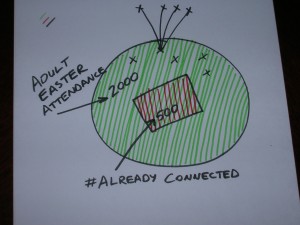Do You Know about This Game-Changing Connection Secret?
 Spoiler Alert: The most connected people in your congregation almost always have the fewest connections in the community.
Spoiler Alert: The most connected people in your congregation almost always have the fewest connections in the community.
Four Things You Need to Know
I use this drawing to illustrate this important concept. There are four things you need to know in order to understand the drawing,
First, the circle represents your adult attendance on Easter. As you know, the difference between your average adult attendance and your Easter adult attendance is not that everyone brings a friend. Instead, the main reason your attendance is higher on Easter is that everyone comes on the same weekend.
Second, the square represents the people in your congregation who are truly connected. That is, if something happened to them or a member of their family, someone else in your congregation would find out about it within 24 hours without anyone calling the church. A pink slip at work. Marital issues. A scary medical diagnosis. A teenager who goes south. 24 hours. Someone else knows.
Third, if you were to interview the folks in the square (the most connected people in your congregation) and ask who their 10 closest friends are in your area, you’d find out that 8, 9, or even all 10 of them are also inside the square. Now, before you get excited, there are exceptions (many church staff members, those with the gift of evangelism, etc.). But in general, the most connected people in your congregation are the least connected in the community.
Fourth, when you interview the folks in the circle you’ll find out that 8, 9, or even all 10 of their best friends have never been to your church. Let me repeat that:
When you interview the folks in the circle you’ll find out that 8, 9, or even all 10 of their best friends have never been to your church.
Here’s the big idea: If you want to recruit hosts who can fill their own group with unconnected neighbors, friends, co-workers and family members…you need to learn how to recruit from the circle. Churches that keep going back to the well of the usual suspects (the most connected) shouldn’t be surprised when hosts from the square don’t know their neighbors.
What do you think? Have a question? Want to argue? You can click here to jump into the conversation.


Mark, thanks! Was looking for an answer to a question about this very thing and you came through in just the right time!
Awesome! Glad the article was helpful.
mark
Ah Mark… recruiting from the circle sounds easier than actually done! I am finding that those in the circle want to be connected BUT without the accountability (reports, leadership training, etc.). Also the youngin’s in the circle really don’t want to be connected to anything structured …
So much depends on how you’re approaching the recruiting process. For example, this article is really about the power of recruiting leaders from the circle whose friends and closest connections are also in the circle (or even outside of the circle). The right “ask” combined with the right topic will recruit that kind of person.
At the same time, I’d say there’s no question that certain segments of your crowd will be less likely to respond. Don’t let the preferences of certain groups keep you from working it with others. Remember…there is no problem-free. Other strategies may work well with that group.
Oh, and one more thing, every connecting strategy is hard to refine and implement. If they were easy, everyone would already be connected!
mark
Very helpful.
Glad you found the post helpful!
mark
Mark, where did you get the numbers for your comparisons?
Purely anecdotal, but confirmed over many, many sidebar conversations. The numbers stand up very well with the exception of motivated staff members and members with the gift of evangelism.
mark
Outstanding article! Churches that can cast this vision to new converts or new members can experience explosive growth – and not just transfer growth, but the real deal: unchurched people. This is how the Early Church reached so many outsiders. I love the simplicity of your graphic… it makes the concept clear and easily transferrable.
Thanks Jon! Glad to hear the diagram is helpful!
mark